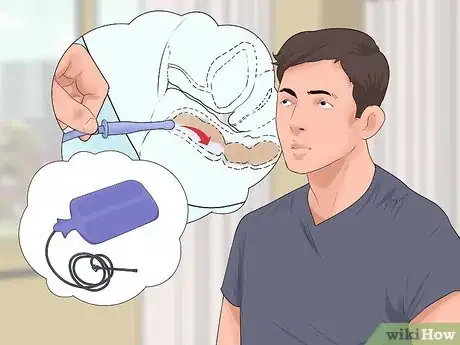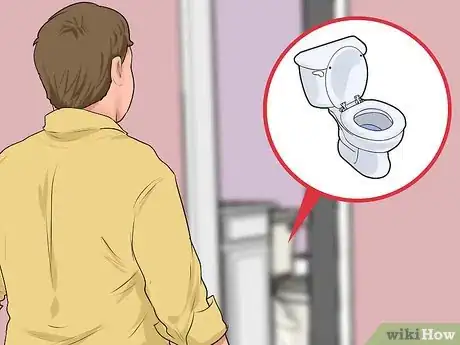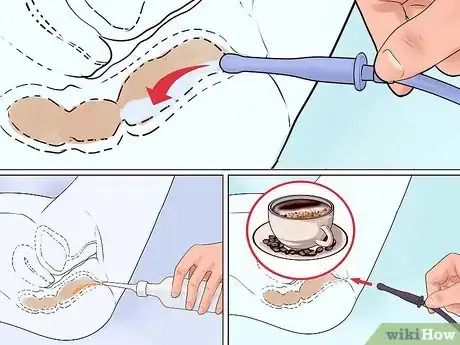This article was medically reviewed by Luba Lee, FNP-BC, MS. Luba Lee, FNP-BC is a Board-Certified Family Nurse Practitioner (FNP) and educator in Tennessee with over a decade of clinical experience. Luba has certifications in Pediatric Advanced Life Support (PALS), Emergency Medicine, Advanced Cardiac Life Support (ACLS), Team Building, and Critical Care Nursing. She received her Master of Science in Nursing (MSN) from the University of Tennessee in 2006.
There are 9 references cited in this article, which can be found at the bottom of the page.
wikiHow marks an article as reader-approved once it receives enough positive feedback. In this case, 85% of readers who voted found the article helpful, earning it our reader-approved status.
This article has been viewed 499,993 times.
Enemas can be composed of different solutions and be administered for a variety of reasons. There are already prepared enemas that can be bought in any drugstore or you can use an enema bag. Either way, the process of administering an enema is the same and involves inserting the liquid form of the chosen substance into the lower colon through the rectum. Consult with your physician before administering an enema to determine, firstly, whether it is a good option for you and, secondly, what type of enema should be used.
Steps
Preparing the Enema
-
1Prepare for the enema. No matter the goal of the enema, the way in which it is administered is the same. However, if the goal is retention, then enemas are best done after a normal bowel movement and at least a few hours after eating. Don't eat right before doing an enema. For constipation, the enema is given to help evacuate the bowel.
- Empty your bladder before an enema to reduce the discomfort associated with adding fluid to the bowel.
- Obtain an enema bag or a Fleets enema bottle from a pharmacy. The first uses fluid prepared at home while the second is a self-contained unit.
- Place a waterproof pad under the area where you will lie down in case you inadvertently release the fluid before reaching the bathroom.[1]
-
2Fill a clean enema bag, if using. Fill an enema bag with the solution recommended by your doctor. Make sure that the clamp is on to contain the fluid. Once the bag is full, hold the bag, hose end down, and open the clamp momentarily to allow the fluid to purge any air from the hose, and then close the clamp. This will help you to avoid introducing air into the colon, which can cause cramps.[2]
- In general, you use smaller amounts of fluid for retention enemas so the rectum is not overwhelmed with the amount of fluid and the individual can retain it without discomfort. Your doctor will instruct you on how full the bag should be.
- Never share an enema bag, even if it has been cleaned.
Advertisement -
3Prepare the enema tube. Measure and mark 4 in (10 cm) on the enema tube so you are assured the tube is not inserted more than 4 in (10 cm) into your rectum.[3]
- Lubricate the end of the tube with a lubricant product, like KY jelly, to make insertion more comfortable.
Getting into Position for the Enema
-
1Hang the bag 12 to 18 in (30 to 46 cm) above the rectum. The administration of fluid in a bag uses gravity. Your best bet is to hang it on a hook or stand near where you are going to administer it.[4]
- You could also have someone hold the bag for you if you don't have anywhere to hang it.
-
2Lie down on your left side with your knees pulled up to your chest. This changes the position of the lower colon so it is able to receive more fluid from the rectum. Anatomical positioning of the lower colon and gravity will help the fluid to go higher in the colon. Turn your head to one side, and place your left arm under your head.[5]
-
3Insert the lubricated enema tube into your rectum. Separate the buttocks and identify the anus, or the outside of the rectum, where the tube will be inserted. Slowly insert the end of the enema tube, or the lubricated end of a Fleet's enema bottle, into the rectum approximately 3.5 in (8.9 cm).[6]
- While inserting the tube into the anus, bear down and push the anus out as if for a bowel movement.
- Never force the tube in! If you can't get it in, do not continue trying. Call your physician to discuss what to do next.
Releasing the Clamp and Evacuating
-
1Allow the fluid to enter your rectum. If using an enema bag, release the clamp and allow the fluid to fill inside. If using a Fleet's enema bottle, apply gentle pressure to the bottle. Gently roll the bottle from the bottom to the top so there is no backflow into the bottle.[7]
-
2Wait for all the fluid to enter the rectum. Breathe through your mouth if you feel cramps. Close the clamp temporarily, until cramping eases, then resume the flow. Watch the bag until it is empty and remove the nozzle. If using the Fleet's enema bottle, keep the bottle rolled and gently remove the tube.[8]
-
3Go to the bathroom and evacuate. If suffering from constipation, try to keep in the lying down position for at least 5 minutes and up to 1 hour before going to the bathroom and expelling the fluid.
- If the enema was administered for retention and absorption, you may want to stay on your left side for 10 minutes, roll to your back for 10 minutes and then your right side for 10 minutes to help the fluid move through the large colon.
-
4Watch for side effects. As with any medical treatment, there is the possibility that you may experience some side effects after administering an enema. During the procedure, you may experience a feeling of fullness and some discomfort. Cramps and gas may also persist for a few hours after the enema. Tell your doctor promptly if these symptoms continue any longer than a few hours after the enema has been administered.[9]
- Using enemas too frequently can result in dehydration and an electrolyte imbalance. Although your body can absorb liquid from the rectum, it can also lose electrolytes from the blood if the fluid in the rectum is hypotonic (or has less electrolytes than in the blood) or can irritate the colon to expel more waste material than intended.
- Dehydration can have serious side effects for both the heart and kidneys. Decreased urination, dry mouth, increased thirst, lack of tears, dizziness, lightheadedness, or pale and wrinkled skin can all be symptoms of dehydration.
- An allergic reaction to any of the medications commonly used in enemas is rare. However, if you experience an allergic reaction, which involves symptoms such as a rash, itching, swelling, severe dizziness, or trouble breathing, call your physician immediately.
Understanding Enemas
-
1Understand the purposes of enemas. For the most part, people use enemas in order to treat constipation. When unable to fully evacuate the bowels, an enema can stimulate the colon to contract and force stool out of the body. The enema can also soften the stool that is there, making it easier to expel. But constipation is only one reason why an enema might be administered nor should it be considered a consistent form of relief from constipation. Long-term usage of enemas to relieve constipation can cause serious damage to your bowels and your ability to have a natural bowel movement.[10]
- Gerson therapy also makes use of enemas. Gerson therapy is a therapeutic approach to cleansing the body of toxins which does not rest on solid scientific research. The basis of the approach involves treating cancer based on diet and nutritional intake, including the use of coffee enemas, which are an essential part of the regimen.[11]
- Retention enemas are another form of enemas that have long been used to administer medications (including antibiotics and anti-seizure medications) and fluids to the body when oral administration was not possible. The rectum is a cavity in the body which is fully able to absorb nutrients and fluids.[12] Medications have been given through suppositories but fluids are more readily absorbed into the body than medications via oil-based suppositories. In cases where IV administration is not possible, retention enemas can be helpful in the treatment of dehydration triggered by vomiting.[13]
- Cleansing enemas are used to help the body rid the lower intestines of waste or to administer specific herbs which are expected to be absorbed into the body. Cleansing enemas can be either large- or small-volume enemas which are designed to irritate the colon to produce peristalsis and encourage evacuation of the rectum and large intestines.
- Always consult your doctor before performing any kind of enema.
-
2Consider the different solutions used in enemas. Enemas can be made at home or purchased in the store. The fluid used can be medicated or just water. What is used will depend upon the goal of treatment. Consult with your doctor as to what is the best option for you. Here are some different types of enema solutions:
- Tap water enemas should always use small volumes because the fluid is hypotonic, meaning it will pull electrolytes out of your blood and into the enema, which you then expel. This increases the risk of an electrolyte imbalance.
- A soap-suds enema can be used but only when pure castile soap is used. Other, harsher soaps can be dangerous to instill in an enema.
- Oil retention enemas are given to help soften the stool in the rectum, making it easier to pass. Adults may use an enema up to 150 ml and children up to 75 ml. The enema should be retained for 30 to 60 minutes, giving the oil time to penetrate and coat the stool.
- Powdered milk and molasses is a comfortable enema to use and one of the best treatments for severe constipation. Ask your doctor if this might be helpful for you and to get specific instructions on how to do it.
- Coffee enemas are used to detoxify and cleanse the bowel. Coffee, when administered rectally, stimulates bile production to help eliminate toxins and improve liver activity. Use coffee that has been boiled for 10 minutes and then cooled to room temperature or grounds that have been soaked overnight. In both cases the water should be strained before the fluid is used. Try to use organically grown coffee to reduce your exposure to pesticides. Note that coffee enemas do not deliver the caffeine you receive when drinking the beverage orally.[14]
-
3Know the contraindications. It's important that you be aware of the contraindications of using an enema, which are conditions or factors that would make the treatment unsuitable for or harmful to you. In general, enemas are not harmful. However, there are some individuals who should not use enemas, particularly medicated enemas.[15]
- Do not use medicated enemas if you have severe kidney disease, congestive heart failure, obstruction in your stomach or intestines, paralytic ileus, megacolon or active inflammatory bowel disease. If you are dehydrated, you should also not use an enema.
- Women who are pregnant or nursing must talk with their doctor before taking any medication to determine if the medicine is safe for the baby.
Warnings
- An enema is only an occasional remedy. By using one consistently you risk losing your natural ability to evacuate your bowels.[16]⧼thumbs_response⧽
References
- ↑ https://journals.lww.com/nursing/fulltext/2003/11000/administering_an_enema_to_an_adult.25.aspx
- ↑ https://journals.lww.com/nursing/fulltext/2003/11000/administering_an_enema_to_an_adult.25.aspx
- ↑ https://www.nursingtimes.net/clinical-archive/gastroenterology/how-to-administer-an-enema-16-05-2006/
- ↑ https://journals.lww.com/nursing/fulltext/2003/11000/administering_an_enema_to_an_adult.25.aspx
- ↑ https://www.nursingtimes.net/clinical-archive/gastroenterology/how-to-administer-an-enema-16-05-2006/
- ↑ https://www.nursingtimes.net/clinical-archive/gastroenterology/how-to-administer-an-enema-16-05-2006/
- ↑ https://www.nursingtimes.net/clinical-archive/gastroenterology/how-to-administer-an-enema-16-05-2006/
- ↑ https://www.nursingtimes.net/clinical-archive/gastroenterology/how-to-administer-an-enema-16-05-2006/
- ↑ http://www.webmd.com/drugs/2/drug-14831/fleet-enema-rectal/details#side-effects
- ↑ http://drbenkim.com/articles-enema.htm
- ↑ http://www.cancer.gov/about-cancer/treatment/cam/hp/gerson-pdq#section/_9
- ↑ http://www.ncbi.nlm.nih.gov/pubmed/6126289
- ↑ http://www.listentoyourgut.com/symptoms/46/the-flu-vomiting-gastroenteritis.html
- ↑ http://www.hindawi.com/journals/isrn/2013/147238/
- ↑ https://www.drugs.com/mtm/fleet-enema-rectal.html
- ↑ http://drbenkim.com/articles-enema.htm
About This Article
To administer an enema, start by emptying your bladder to lessen the discomfort. If you’re using an enema bag, make sure to clean it in hot, soapy water before filling it with the solution recommended by your doctor. Once the bag is full, measure and mark 4 inches on the enema tube so you know when to stop inserting it in your rectum, then coat the end of it with a lubricating jelly to make insertion more comfortable. When you’re ready, lay on your left side with your knees pulled up to your chest. Insert the tube into your rectum and allow the fluid to enter your body. After you’re done, remain in this position for a few minutes before going to the bathroom. For more tips from our Medical co-author, including how to tell if you’re having any side effects from your enema, keep reading!








































































Medical Disclaimer
The content of this article is not intended to be a substitute for professional medical advice, examination, diagnosis, or treatment. You should always contact your doctor or other qualified healthcare professional before starting, changing, or stopping any kind of health treatment.
Read More...